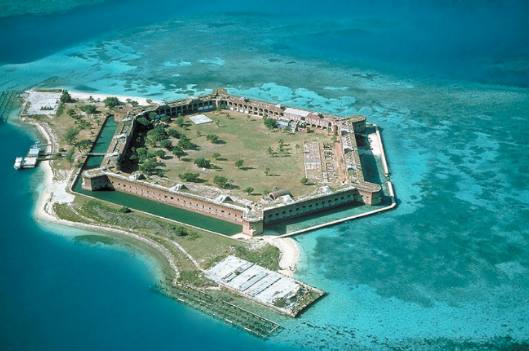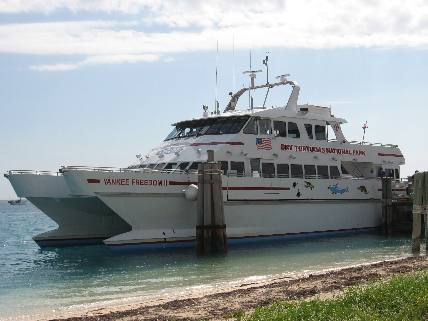Fort Jefferson BricksBricks used in the construction of Fort Jefferson came from Pensacola and New York
These light colored bricks used to construct Fort Jefferson came from Pensacola, Florida 500-miles to the north of the Dry Tortugas. Fort Jefferson was constructed to hold the Tortugas anchorage against strong naval attack. But you have to understand that in the mid-1800's the Dry Tortugas were in a very strategic location. Fort Jefferson was built to protect one of the most strategic deepwater anchorages in North America. By fortifying this spacious harbor, the United States could maintain an important “advance post” for ships patrolling the Gulf of Mexico and the Straits of Florida. Keep in mind that during the mid-1800's commerce was flowing from the interior of our country down the Mississippi River and a dozen other rivers that connected the interior to markets. Take out a map and look at the location of Fort Jefferson in the Dry Tortugas 70-miles west of Key West. The islands and shoals that make up the Dry Tortugas are navigation hazards that has been the graveyard for hundreds if not thousands of ships. However, the harbor offered ships a chance to resupply, refit, and seek refuge from storms. The location of the Tortugas along one the world’s busiest shipping lanes was its greatest military asset. Though passing ships could easily avoid Fort Jefferson’s guns, they could not avoid the warships that used the harbor Fort Jefferson controlled. So it was the "HARBOR" and anchorage at the Dry Tortugas that Fort Jefferson was build to protect. Fort Jefferson and some of the 16-million bricks used to construct it
If you look closely you can see that two different colors of brick were used in the construction. Look closely and you can see darker red bricks used on the very top. Those bricks were shipped to Fort Jefferson during the Civil War when the bricks were NOT being obtained from Pensacola, Florida.
I can also see some dark colored bricks that are used in the moat wall at the very bottom. While you can not detect it from here there is a large moat between where we are standing and the fort itself. Fort Jefferson sits on Garden Key which is only a 16-acre island and Fort Jefferson consumes 10-acres of Garden Key. Joyce at Fort Jefferson in the Dry Tortugas
The only way to visit Fort Jefferson is by sea plane or boat. We boarded the Yankee Freedom II in Key West this morning for 70-mile ride out to the Dry Tortugas and Fort Jefferson. Bricks from two suppliers were used in the construction of Fort Jefferson
Both red and yellow bricks make up Fort Jefferson. The yellow bricks were placed before the civil war and were from Pensacola, Florida. The red bricks were shipped to the island from the North during the civil war. Take a close look and spot the different bricks used in the construction of Fort Jefferson. The light colored bricks came from Pensacola, Florida 500-miles north of the Dry Tortugas. When the Civil War broke out Pensacola stopped supplying bricks and they started shipping the dark red bricks from New York 1,400 miles away. In 1874 all work on Fort Jefferson stopped, the people left, and the fort was officially abandoned. Keep in mind that 1874 is about 10-years after the Civil War ended. Keep in mind that 16-million bricks were used in the construction of Fort Jefferson. No shots were ever fired from Fort Jefferson.
Fort Jefferson in the Dry Tortugas
Fort Jefferson’s walls are 45 feet tall and 8 feet thick. It is one mile around this fort. Keep in mind that 16-million bricks were used in the construction and for the record the fort was never completed before it was abandoned in 1874. You can also see the different colors of bricks used in the construction if you look closely. The light colored bricks on bottom came from Pensacola, Florida. Then the bright red bricks on top were used during the civil war and they were brought in from New York.
View from the air of Fort Jefferson in the Dry Tortugas
This is what Fort Jefferson looks like today. It is still a huge fort even today. Keep in mind that Fort Jefferson is the largest brick fort in the Western Hemisphere. It was constructed to hold the Tortugas anchorage against strong naval attack. The anchorage they were defending is that deep blue water in the top right corner of this picture. As you can see the 10-acre fort consumed most all of this 16-acre sand island known as Garden Key.Major supply ports were 500-miles away in Pensacola, Florida for the brick and lumber. Cement and stone were shipped from New York which is 1,400 miles away. Fort Jefferson was the Army Engineer Corps first big "sub-marine" construction with concrete foundations two feet thick, 14' wide and a mile long all built below sea level.
Fort Jefferson was designed as a 3-tier fort with over 400 guns (canons) located so that 125 of them could simultaneously zero in on the same target.
I guess it served its purpose since it never had to fire a shot.
OK, now you need to know how to get to Fort Jefferson.
Yankee Freedom II is the ferry to Garden Key and Fort Jefferson in Dry Tortugas National Park
Since Garden Key and Fort Jefferson are located in the Dry Tortugas 70-miles west of Key West the only way to get here is by boat or sea plane. We opted for the "boat" option and took the Yankee Freedom II ferry from Key West to Fort Jefferson in the Dry Tortugas. The 70-mile ride each way on the Yankee Freedom II is a special treat itself. It takes you past other islands in the Florida Keys chain of islands. However, these islands are not connected to the mainland by bridge. Once you leave Key West Harbor on the Yankee Freedom II you are heading into an area only accessible by boat or sea plane. Thirty miles from Key West the Yankee Freedom II takes you past the Marquesas Keys and thousands of lobster trap buoys and the boats working these lobster traps. The Yankee Freedom II is the ferry service that transports visitors to Dry Tortugas National Park every day. Click here for more Key West travellogsUntil next time remember how good life is. More Florida AdventuresMore Key West Adventures ** More 2011 Travel Adventures
Mike & Joyce Hendrix
Mike & Joyce Hendrix who we are We hope you liked this page. If you do you might be interested in some of our other Travel Adventures: Mike & Joyce Hendrix's home page Travel Adventures by Year ** Travel Adventures by State ** Plants ** Marine-Boats ** Geology ** Exciting Drives ** Cute Signs ** RV Subjects ** Miscellaneous Subjects
We would love to hear from you......just put "info" in the place of "FAKE" in this address: FAKE@travellogs.us Until next time remember how good life is. |
| ||
|
| |||
|
| |||
|
|

